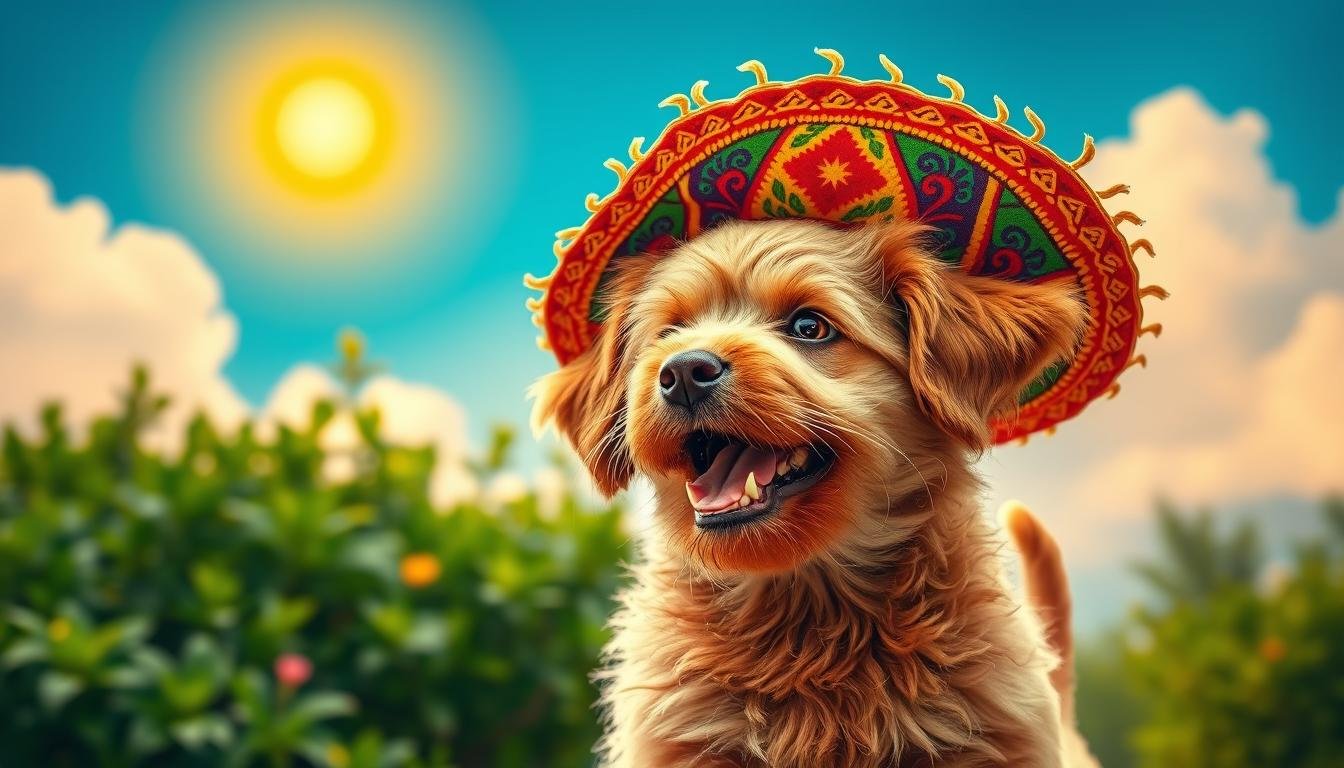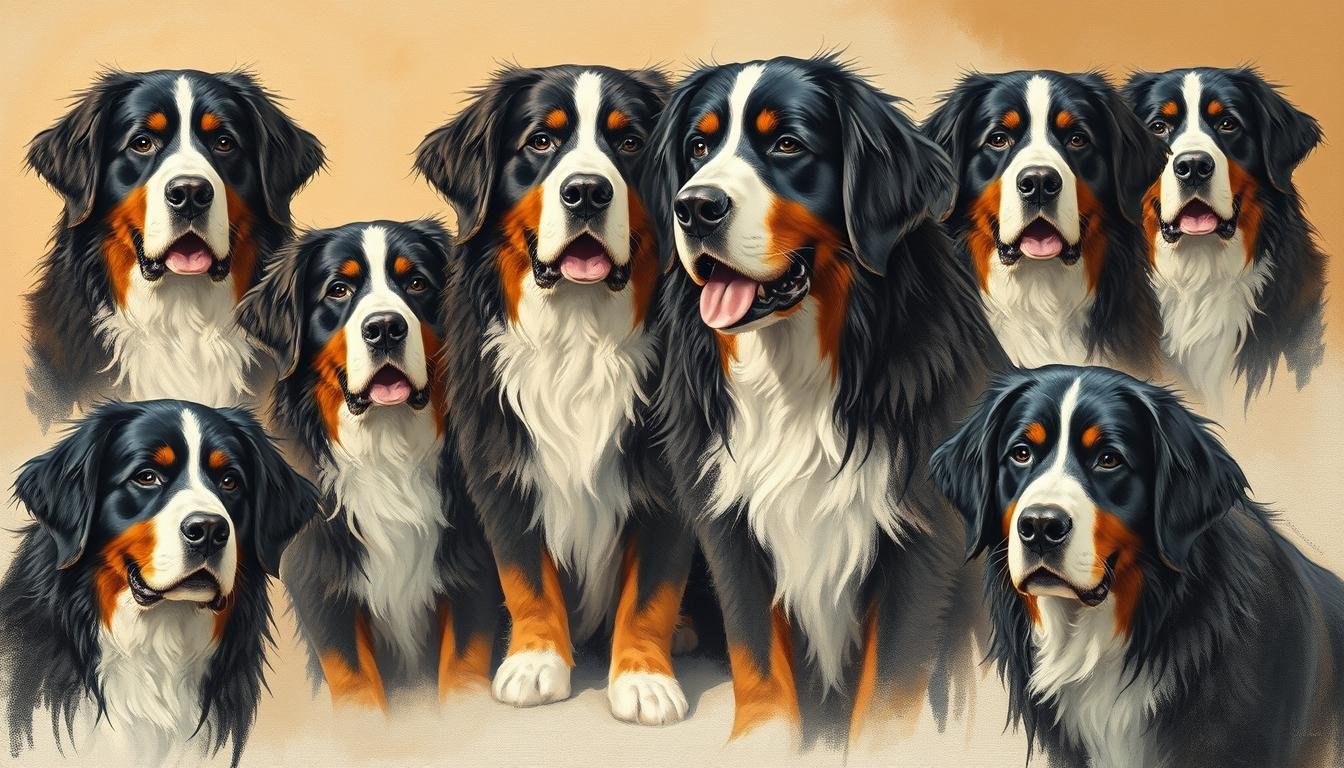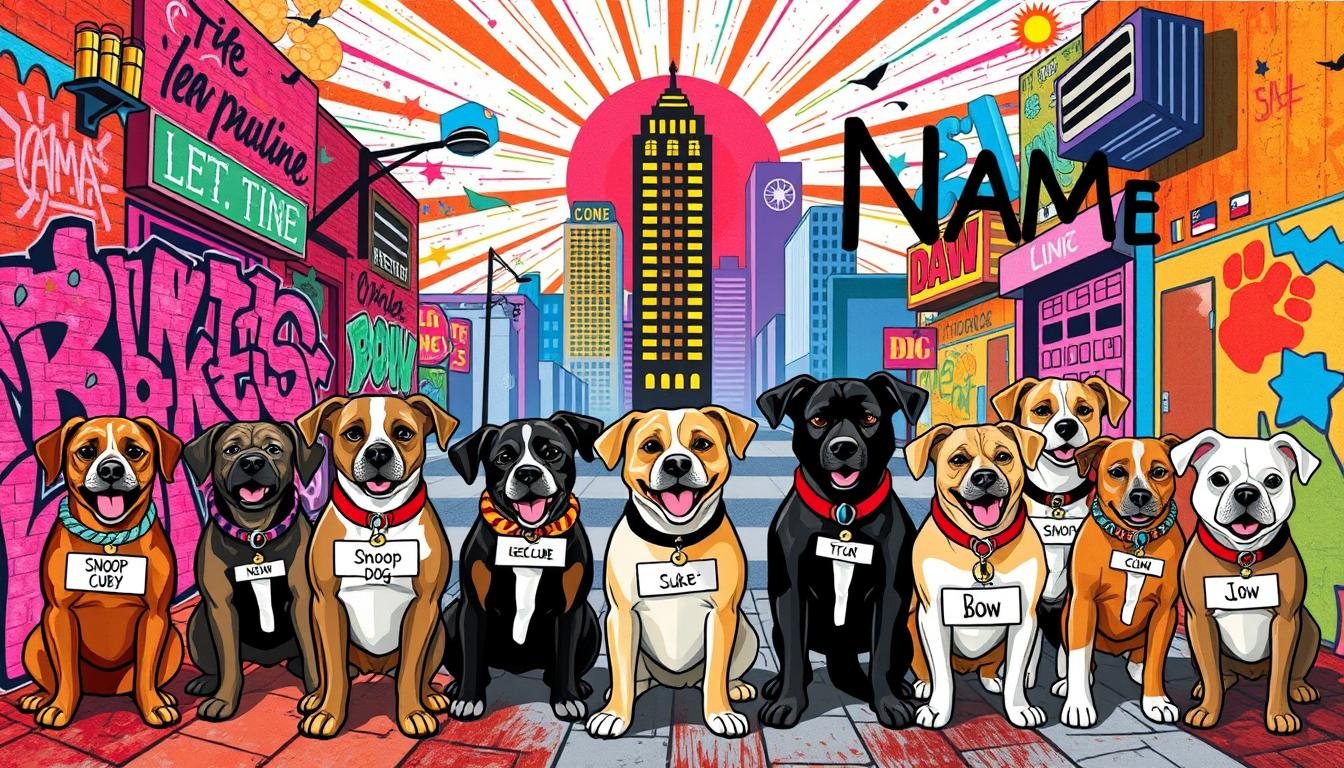Ever tried choosing between two friends who both promise endless loyalty, slobbery affection, and enough fur to knit a winter wardrobe? That’s the dilemma we face with these gentle giants. Whether you’re drawn to the soulful eyes of one or the work ethic of the other, both breeds have a knack for making you question how you ever lived without 120 pounds of pure devotion in your life.
Let’s start with their origin stories – because every superhero needs one. The Canadian-born marvel likely descended from Viking companions and water-rescue specialists, while its Swiss counterpart evolved from Roman war dogs turned alpine multitaskers. Their histories read like adventure novels, complete with tax rebellions and mountain survival sagas.
What truly unites them? A shared mission to disprove the myth that big dogs can’t be big softies. We’ve seen these ”living teddy bears” turn skeptics into converts with one head-in-lap sigh. But beneath those fluffy exteriors lie fascinating differences in temperament, care needs, and even drool management strategies.
Through our comprehensive comparison, we’ll help you navigate the quirks that make each breed extraordinary. Because choosing between these furry soulmates shouldn’t feel like picking a favorite ice cream flavor – both are deliciously wonderful, just in different ways.
Key Takeaways
- Both breeds combine massive size with exceptionally gentle personalities
- Origins trace back to specialized historical roles in Canada and Switzerland
- Unique care requirements stem from their distinct working backgrounds
- Trainability and family compatibility differ despite similar appearances
- Proper grooming and space needs are critical for happy cohabitation
- Lifespan and health considerations vary between the two breeds
Breed Histories and Origins
History buffs and dog lovers alike will find these origin tales as gripping as a Netflix documentary. One breed survived government taxation chaos, while the other perfected alpine multitasking before Switzerland had chocolate banks.
From Maritime Helpers to Family Companions
Imagine nearly vanishing because of a dog tax. In the 1780s, Canadian families faced impossible choices when ownership fees spiked. Many surrendered their water-rescue partners to avoid financial ruin. But fate intervened when painter Edward Landseer turned them into Victorian-era celebrities through his artwork – essentially creating the original “influencer pet” trend.
Swiss Working Roots and Evolution
Meanwhile, Roman soldiers left behind four-legged treasures in the Alps around 100 AD. These versatile workers hauled milk carts and guarded livestock for centuries before organized breeding began. The 1899 formation of Club Berna ensured their legacy, with a 1904 dog show cementing their official name – proving even mountain herders need branding.
| Aspect | Maritime Specialists | Alpine Experts |
|---|---|---|
| Original Purpose | Water rescue & fishing aid | Farm labor & cart pulling |
| Revival Milestone | 1800s artistic fame | 1904 international recognition |
| Modern Adaptation | Therapy & family roles | Show rings & companionship |
Both breeds transformed from essential workers to beloved companions. Their survival stories remind us that greatness often emerges from adversity – whether dodging taxes or outlasting empires.
Temperament and Personality

Imagine a security guard who moonlights as a kindergarten teacher – that’s the paradoxical charm of these breeds. Their behavioral superpower lies in balancing protective instincts with melt-your-heart gentleness.
The Social Butterfly Effect
One breed greets life like a toddler at a birthday party – all wagging tails and full-body wiggles. Their reputation as “furry nannies” stems from legendary patience with tiny humans who treat them like living jungle gyms. We’ve watched them tolerate tea parties where the “tea” is actually drool.
Quiet Devotion Personified
The bernese mountain dog approaches strangers like a librarian assessing loud patrons – polite but reserved. Once trust is earned? They become shadow companions, leaning against legs during movie nights and monitoring backyard playdates with quiet intensity.
Three traits make both breeds family favorites:
- Intuitive understanding of children’s energy levels
- Comedic timing during training sessions (sit commands often involve dramatic plops)
- Emergency brake reflexes when play gets too rowdy
Their eagerness to please makes easy train sessions feel like cooperative games. Just don’t be surprised when they outsmart you – these clever companions know exactly how to negotiate extra treats.
Size and Appearance
Like comparing the Statue of Liberty to Mount Rushmore, these breeds command attention through sheer presence. Their physical differences go beyond measurements – they tell stories of purpose-bred design shaped by centuries of specialized work.
Distinct Physical Builds and Stature
One breed resembles a living life preserver with broad chests that could double as flotation devices. Males can reach 150 pounds – equivalent to carrying a full-grown kangaroo in your living room. Their muscular frames suggest they could pull a pickup truck… and probably would if you left the keys nearby.
The Swiss counterpart displays compact power through balanced proportions. Though lighter in weight, their sturdy legs hint at generations of alpine herding. Think less “maritime linebacker” and more “nimble mountain athlete.”
Coat Colors and Patterns
Nature’s tuxedo versus Swiss precision – their coat differences are sartorial masterpieces. One sports water-resistant fur in midnight black or striking gray-and-white patterns perfect for stealth lake rescues. The other wears trademark tricolor markings so precise they could’ve been applied with a laser level.
These visual distinctions aren’t just about aesthetics. Thick double layers demand weekly brush-a-thons, while shorter fur still sheds enough to stock a pillow factory. Choose your vacuum accordingly.
newfoundland dog and bernese mountain dog: Core Differences
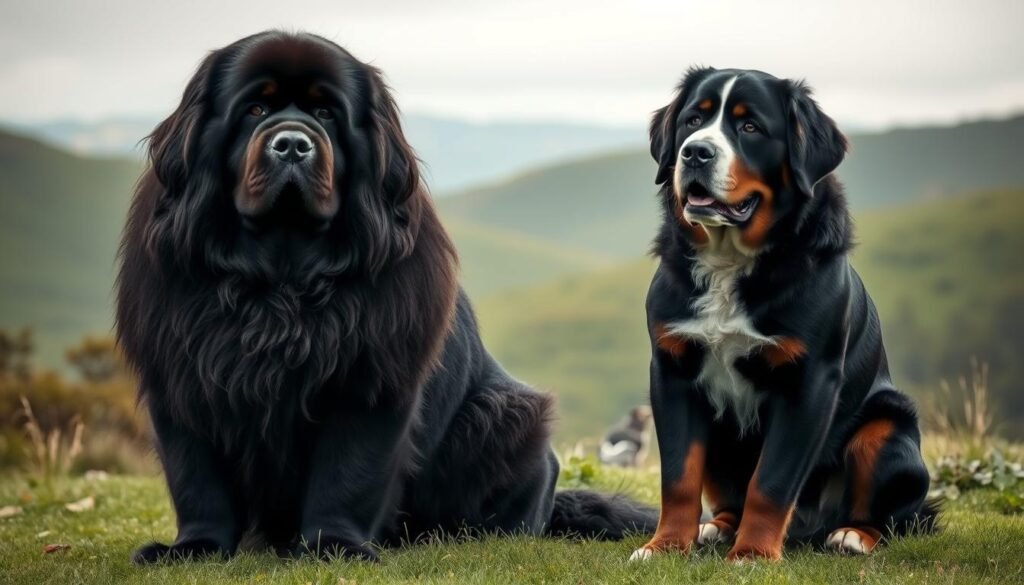
It’s not just size that sets them apart – their approach to life’s adventures differs as much as their heritage. Picture this: one greets strangers like a politician working a crowd, while the other observes new faces like an art critic assessing a questionable masterpiece.
The social butterfly effect shows up everywhere. Walks become meet-and-greets with the maritime breed, who’ll attempt to charm squirrels and mail carriers alike. Their alpine counterparts prefer curating friendships carefully, reserving enthusiasm for trusted companions.
Weight comparisons tell half the story. At 130-150 pounds, one could moonlight as a living loveseat. The other’s leaner 80-115 pound frame still requires sofa real estate planning – just less rearranging of your entire living room.
- Working DNA shapes behavior: Lifesaver instincts vs farmhand focus
- Chew tolerance levels: “Occasional nibbler” vs “furniture Picasso”
- Space requirements: “Room to swim” vs “space to patrol”
That persistent gnawing habit in the Swiss breed? Thank centuries of herding work. They’ll repurpose your shoes into abstract art if left unstimulated. The water rescue lineage shows through in constant people-pleasing – expect enthusiastic (if soggy) assistancе with dishwashing.
Your choice boils down to lifestyle: constant companionship versus selective camaraderie. Both breeds deliver heart-melting devotion – they just wear their hearts (and drool) differently.
Exercise Needs and Activity Levels

Think of these breeds as nature’s fitness equipment – one’s a treadmill set to mountain mode, the other a resistance pool with built-in flotation. Their approach to burning calories proves that size doesn’t dictate stamina.
Trailblazers vs Tide Lovers
Young adults (ages 1-5) demand three daily walks minimum – think furry personal trainers reminding you to clock those steps. The Swiss-bred athletes treat neighborhood routes like Alpine passes, while their maritime counterparts prefer aquatic adventures. We’ve seen one refuse to walk past a puddle without practicing their butterfly stroke.
From Zoomies to Zzz’s
Post-exercise transformations are comedy gold. After 30 minutes of trail running, the mountain specialist collapses like a deflated air mattress. The water enthusiast? They’ll power down gradually, like a submarine returning to port. Both share one rule: “No walk, no peace.”
| Activity | Alpine Athletes | Maritime Masters |
|---|---|---|
| Daily Minimum | 45-60 minutes | 30-45 minutes |
| Preferred Terrain | Hills & trails | Lakes & beaches |
| Energy Reset | Vigorous play | Buoyant swimming |
Pro tip: Mix moderate exercise with mental challenges. Hide treats in puzzle toys or create backyard obstacle courses. Remember – choosing your gentle giant means committing to their unique movement language. Whether it’s summit-seeking or synchronized swimming, tired paws make happy homes.
Grooming, Coat Maintenance, and Shedding
Welcome to the world where lint rollers become your most-used accessory and vacuum cleaners earn employee-of-the-month honors. Managing these coats requires strategy – think military precision meets hair salon finesse.
Brushing and Bathing Best Practices
Our Swiss friends demand biweekly brush marathons with an undercoat rake. Their triple-layer fur forms mats faster than a toddler tangles headphones. The maritime breed’s water-resistant coat needs slicker brush sessions weekly – unless it’s shedding season, when daily de-furring becomes mandatory.
Seasonal Shedding and Coat Care Tips
Twice yearly, both breeds unleash shedding storms that could stock a pillow factory. Stock up on deshedding tools when temperatures shift – spring brings “indoor blizzards,” while fall delivers enough fur to stuff a mattress. Pro tip: Bribe with peanut butter during grooming sessions – sticky beards beat squirming any day.
Key maintenance differences:
- Alpine coats shed steadily like metronomes
- Maritime fur drops in seasonal tsunamis
- Spayed/neutered pets require extra brushing
Health Considerations and Lifespan
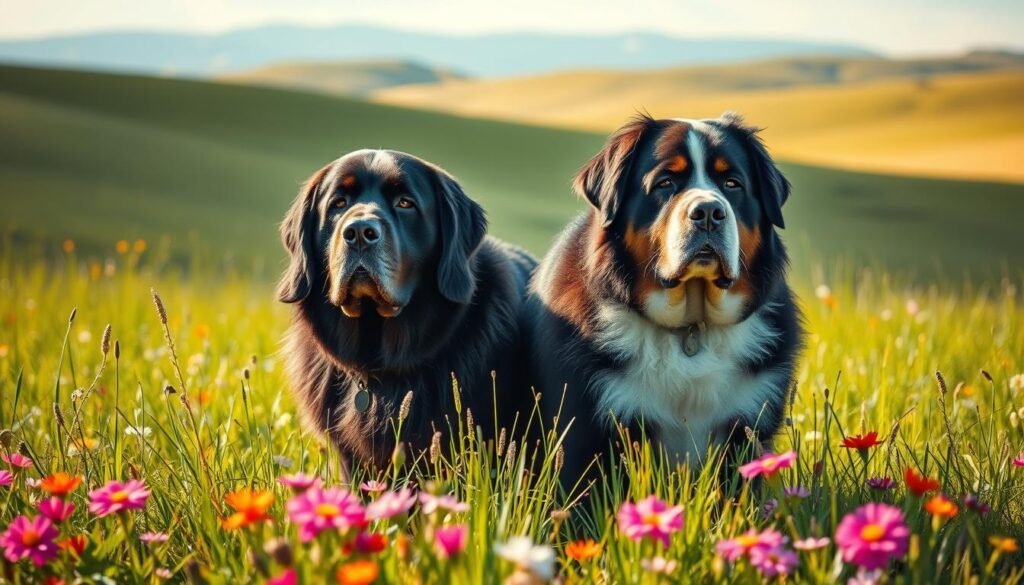
Owning these gentle giants is like investing in a vintage car – regular check-ups keep them purring for years. While their heart-melting eyes might suggest invincibility, responsible ownership means understanding their unique health playbook.
Common Genetic Conditions and Preventive Care
Hip dysplasia and elbow dysplasia top the watchlist for both breeds. We’ve learned that early screening (think puppy X-rays) and weight management can add quality years to their lives. Partner with a vet who speaks “giant breed” fluently – their expertise becomes your secret weapon.
Nutrition and Diet Implications
Feeding these titans isn’t just about quantity – it’s strategic food science. Slow-growth formulas prevent joint stress, while portion control battles the dreaded “puppy obesity.” Our rule? Treats should never exceed 10% of daily calories – unless it’s vet-approved medication disguised as cheese.
Proactive care creates longevity champions. From joint supplements to allergy management, staying ahead of conditions means more tail wags per square mile. Remember: their lifespan might be shorter than yours, but every well-managed health year counts double in dog-time dividends.


